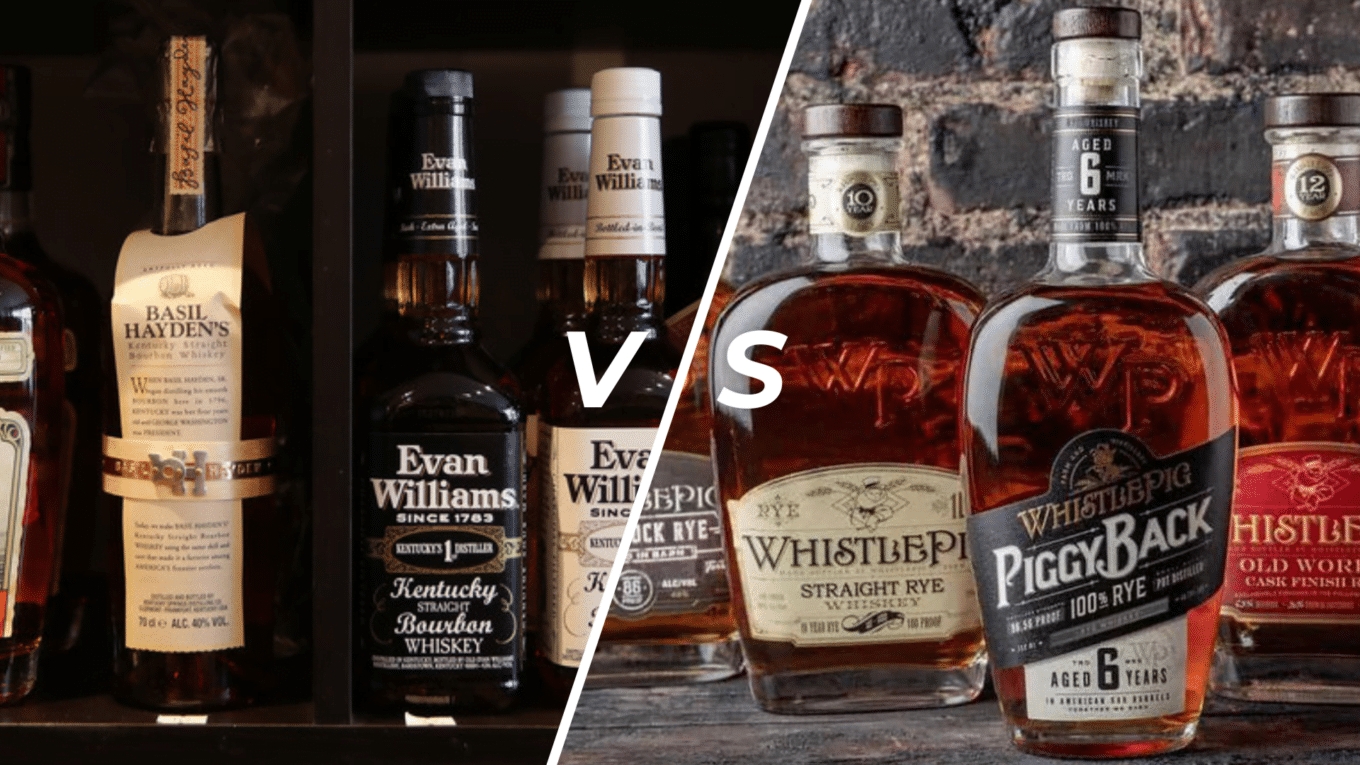When it comes to whiskey, two popular choices often come to mind: rye and bourbon. Both have distinct characteristics that appeal to different palates, leaving many wondering which one to choose.
Rye whiskey is known for its spicy and bold flavor profile, while bourbon offers a sweeter, smoother taste. Deciding between the two can be challenging, especially for those new to whiskey.
In this article, we’ll explore the key differences between rye and bourbon, helping you understand what sets them apart.
We’ll delve into their unique production processes, flavor profiles, and popular brands, providing you with the knowledge to make an informed decision the next time you’re faced with the question: rye or bourbon?
Core Differences Between Rye and Bourbon
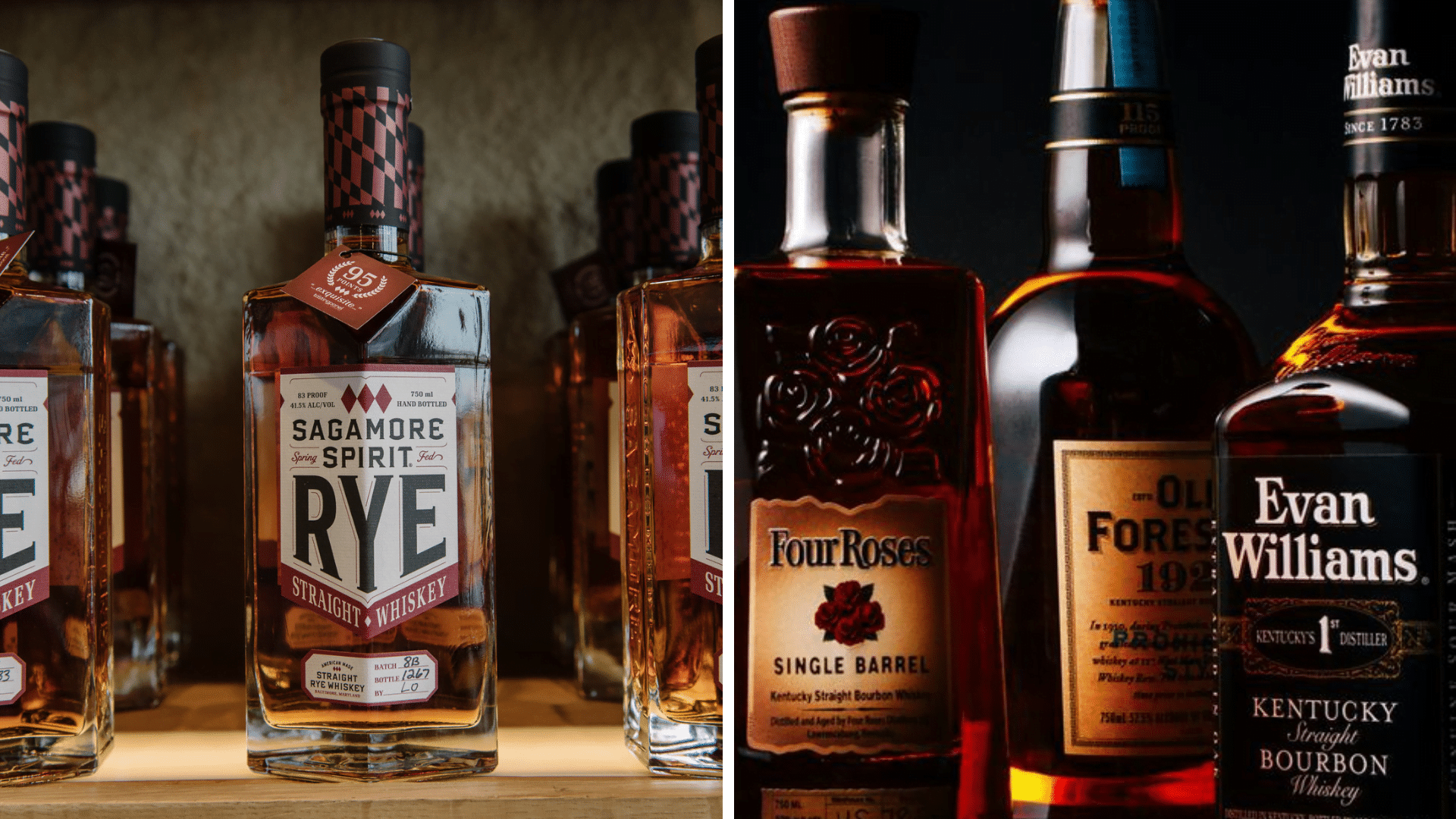
1. Production Standards
| Feature | Rye Whiskey | Bourbon Whiskey |
|---|---|---|
| Legal Requirements | – Must contain at least 51% rye in the mash bill | – Must contain at least 51% corn in the mash bill |
| – Must be distilled to no more than 160 proof | – Must be distilled to no more than 160 proof | |
| – Must be aged in new or used barrels | – Must be aged in new, charred oak barrels | |
| – Must be produced in the United States | – Must be produced in the United States | |
| Distillation Process | – Often uses column stills | – May use column or pot stills |
| Aging | – No minimum aging period, but “straight” rye | – Must be aged for at least 2 years for “straight” |
| is aged at least 2 years | , bourbon |
2. Historial Events in the Development of Rye and Bourbon
- 1600s: Rye whiskey begins production in the northeastern U.S. by European settlers.
- 1783: Bourbon’s origins trace back to the late 18th century in Kentucky.
- 1920-1933: Prohibition significantly impacts the production of rye and bourbon.
- 1933: The end of Prohibition leads to a slow resurgence of bourbon.
- Late 20th Century: Decline in rye popularity.
- Early 21st Century: Resurgence in rye popularity due to renewed interest in classic cocktails.
3. History of Rye &Bourbon
- Origins of Rye: Rye whiskey traces its roots to European settlers who brought their distilling traditions to the American Northeast. It became a popular spirit in the 18th and 19th centuries, particularly in Pennsylvania and Maryland.
- Evolution of Bourbon: Bourbon developed in the late 18th century, with Kentucky becoming its heartland due to the state’s abundant corn crops and limestone-filtered water. It gained popularity throughout the 19th century and became a symbol of American whiskey.
- Historical Impact: Prohibition damaged rye and bourbon production, but bourbon recovered more quickly due to its association with the American South. Rye experienced a resurgence in recent years as cocktail culture revived interest in classic recipes.
4. Ingredients and Mash Bills
- Primary Grains: Bourbon’s mash bill is dominated by corn, which imparts a sweet, smooth flavor. On the other hand, Rye is known for its spicy, peppery notes derived from the grain.
- Secondary Ingredients: Bourbon often includes wheat or rye as secondary grains, while rye whiskey may incorporate corn, barley, or other grains in smaller proportions. These additional ingredients contribute to the complexity and balance of the final product.
- Flavor Influence: Bourbon’s high corn content results in a sweeter, more mellow flavor profile with notes of vanilla, caramel, and oak. Rye’s dominant grain lends a bold, spicy character with hints of pepper, clove, and fruit.
Detailed Comparison Between Rye & Bourbon
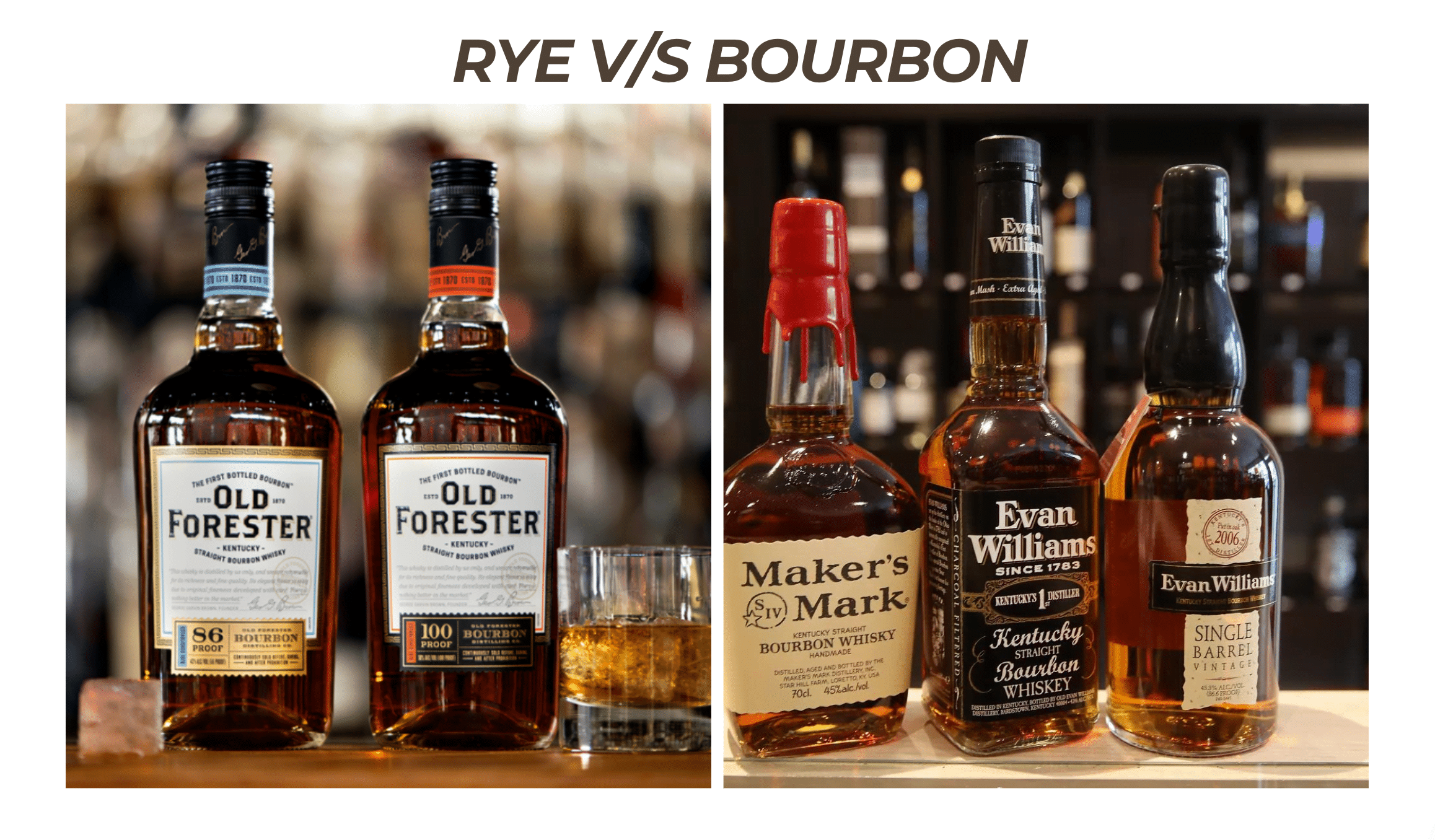
Having looked at the rich histories of rye and bourbon, let’s delve deeper into what sets them apart: their unique production processes and flavor profiles.
1. Production Process
- Distillation: Both rye and bourbon must be distilled to no more than 160 proof and enter the barrel at no higher than 125 proof. Rye is often distilled using column stills, while bourbon makers may use either column or pot stills, which can affect the final product’s complexity and mouthfeel.
- Aging: By law, bourbon must be aged in new, charred oak barrels, while rye can be aged in new or used barrels. Both must be aged for at least two years to be labeled as “straight” whiskey. Kentucky’s hot summers and cold winters create ideal conditions for bourbon aging, while the cooler climates of northeastern states influence rye’s aging process.
2. Flavor Profiles
- Impact of Grain: Bourbon’s high corn content contributes to its sweeter, smoother taste, with notes of vanilla and caramel. Rye’s spicier, bolder flavor comes from the rye grain, which imparts a peppery, fruity character. Secondary grains like wheat in bourbon or barley in rye can add depth and complexity to the flavor profile.
- Sensory Experience: When tasting bourbon, expect a sweet start with hints of vanilla and caramel, followed by a smooth, slightly oaky middle and a warm, lingering finish. Rye offers a spicy, peppery start, a bold, complex middle featuring clove and fruit notes, and a dry, slightly bitter finish.
3. Popular Cocktails
- Signature Drinks: Rye is the traditional choice for classic cocktails like the Manhattan, Sazerac, and Old Pal, where its spicy notes complement the sweet vermouth and bitters. Bourbon shines in drinks like the Old Fashioned, Mint Julep, and Whiskey Sour, where its smooth, sweet profile balances the citrus and sugar.
- Mixing Tips: When mixing cocktails, consider the flavor intensity of your whiskey. Use a higher-proof rye for bold, spirit-forward drinks or a softer, lower-proof rye for more balanced cocktails. Bourbon’s versatility makes it a great choice for experimenting with new twists on classic recipes, such as using smoked or flavored bitters or incorporating fresh fruit juices.
The Top Bourbons and Ryes to Try
Below are the top 7 lists of top Bourbon and Ryes mentioned to make your choice easy:
1. Best High-Rye: High n’ Wicked Bourbon
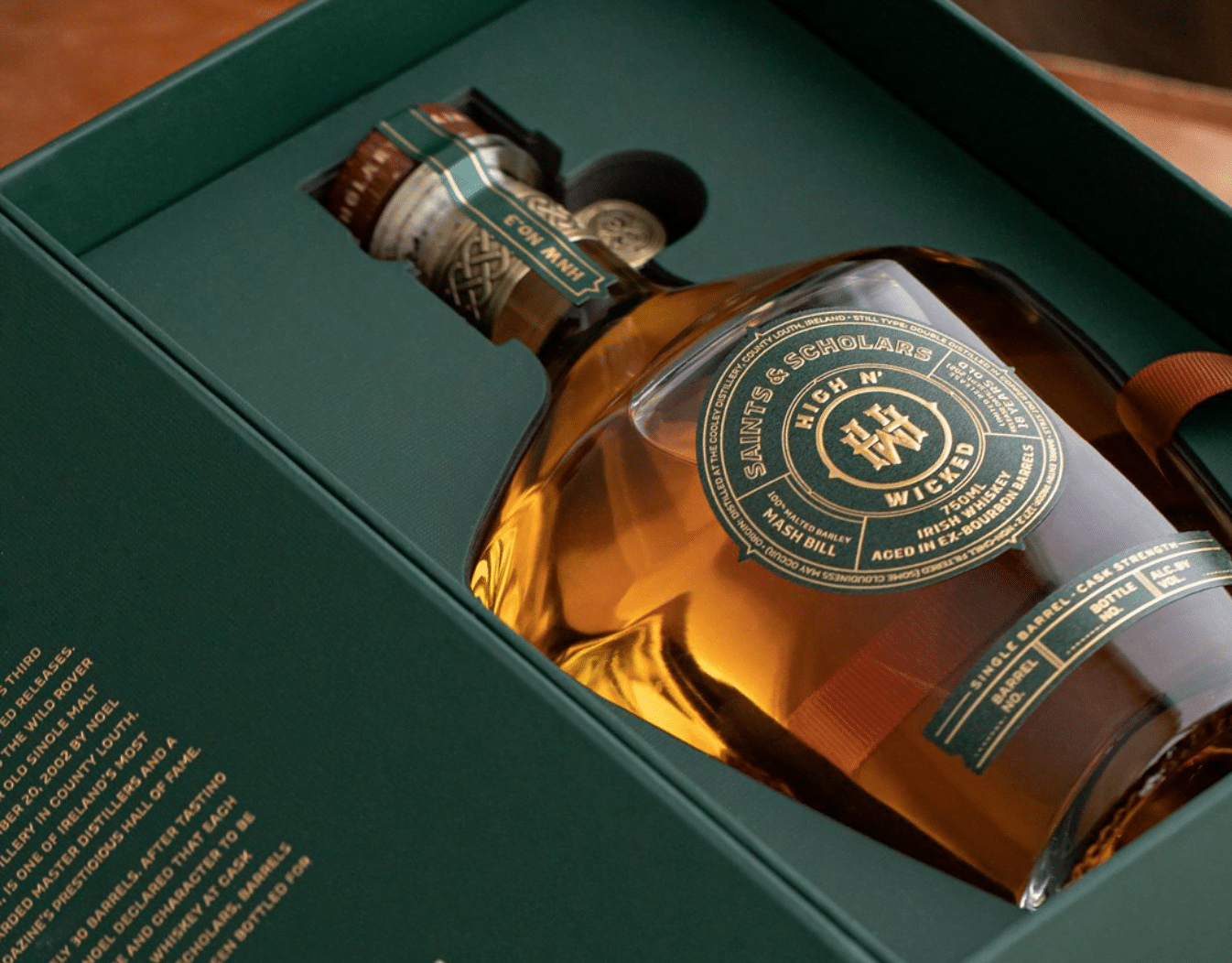
| Aspect | Details |
|---|---|
| Taste | Spicy kick, mellow toffee, oak, sarsaparilla, allspice, nutmeg, clove, butterscotch |
| Color | Rich amber |
| Price | $90-$100 |
| Major Components | Undisclosed mash bill, high rye content |
2. Best Beer-Bourbon Crossover: Dragon’s Milk Beer Barrel Bourbon
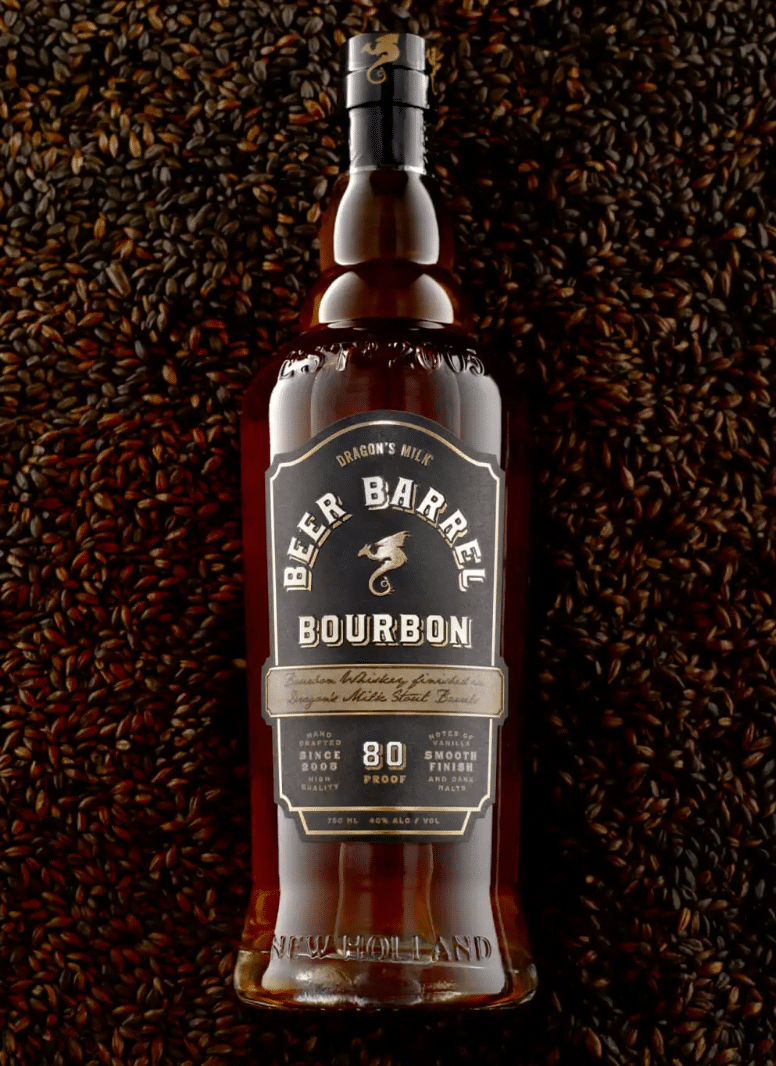
| Aspect | Details |
|---|---|
| Taste | Hoppy aroma, roasted malt, cocoa nibs, apple, citrus |
| Color | Deep amber with reddish undertones |
| Price | $30-$40 |
| Major Components | Aged in Dragon’s Milk Stout barrels |
3. Best Bottled-in-Bond: Old Fitzgerald 11 Years Old Bourbon
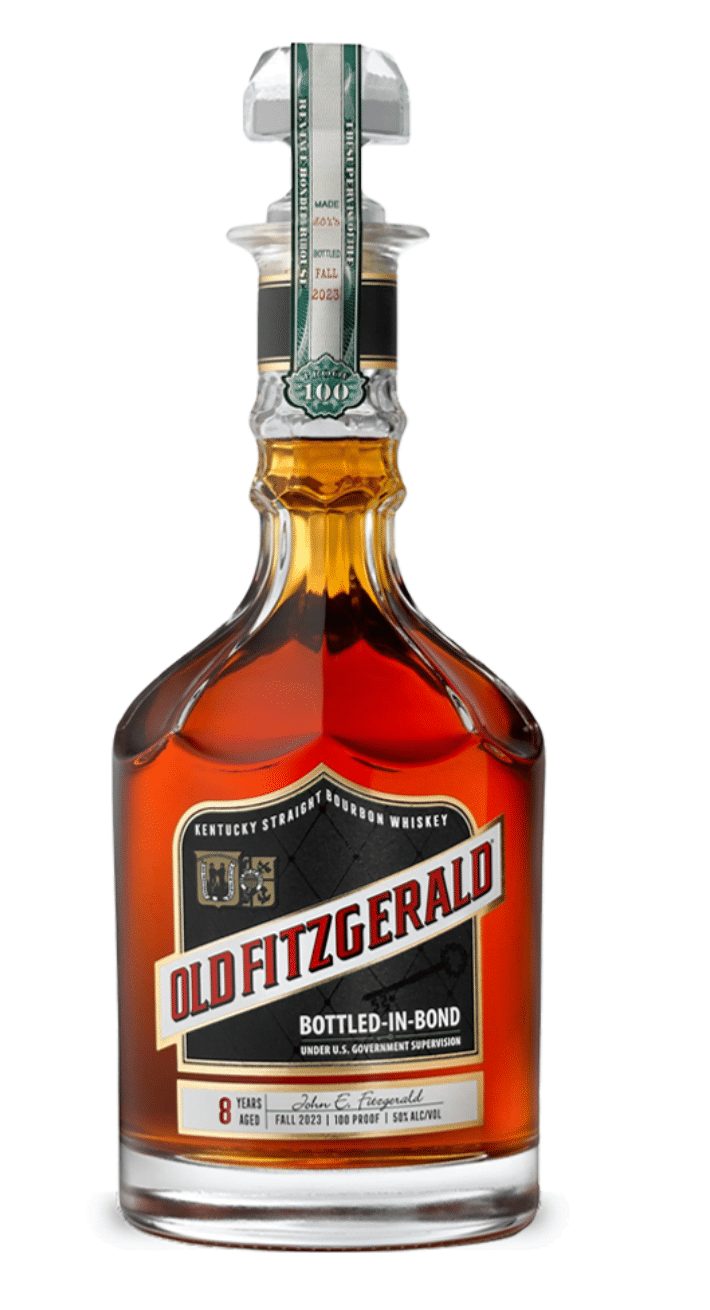
| Aspect | Details |
|---|---|
| Taste | Caramel, toffee, espresso, ginger, black pepper |
| Color | Deep amber to mahogany |
| Price | $800-$900 |
| Major Components | Bottled-in-bond, 11 years, 100 proof |
4. Best Blended: Barrell Bourbon Batch #035
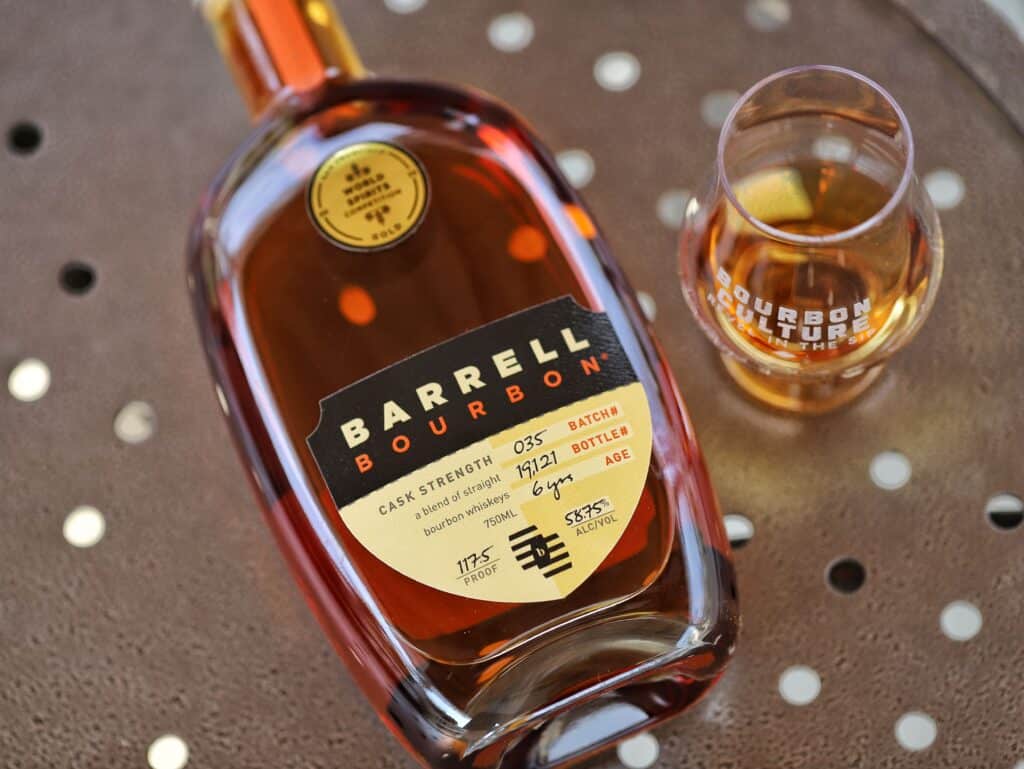
| Aspect | Details |
|---|---|
| Taste | Caramel, toffee, dark chocolate, espresso, ginger |
| Color | Deep amber |
| Price | $90-$100 |
| Major Components | Blend of bourbons from TN, KY, IN, aged 6-14 years |
5. Best Canadian: Lot No. 40 Canadian Rye Whiskey
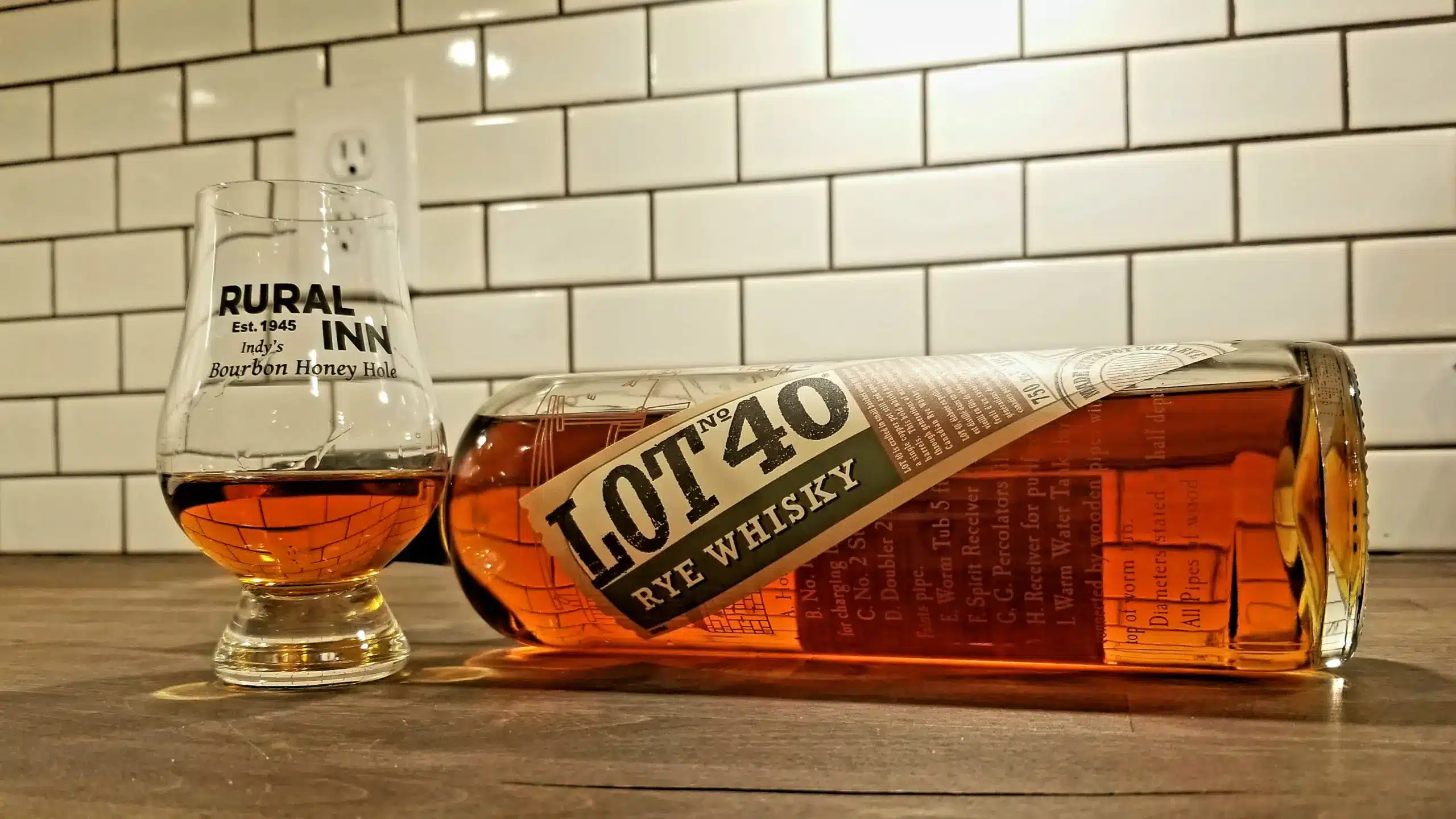
| Aspect | Details |
|---|---|
| Taste | Full-bodied, spicy, caramel, oak, cinnamon, clove |
| Color | Deep amber |
| Price | $35-$45 |
| Major Components | 100% rye, new oak barrels |
6. Best Unexpected: Stauning Rye
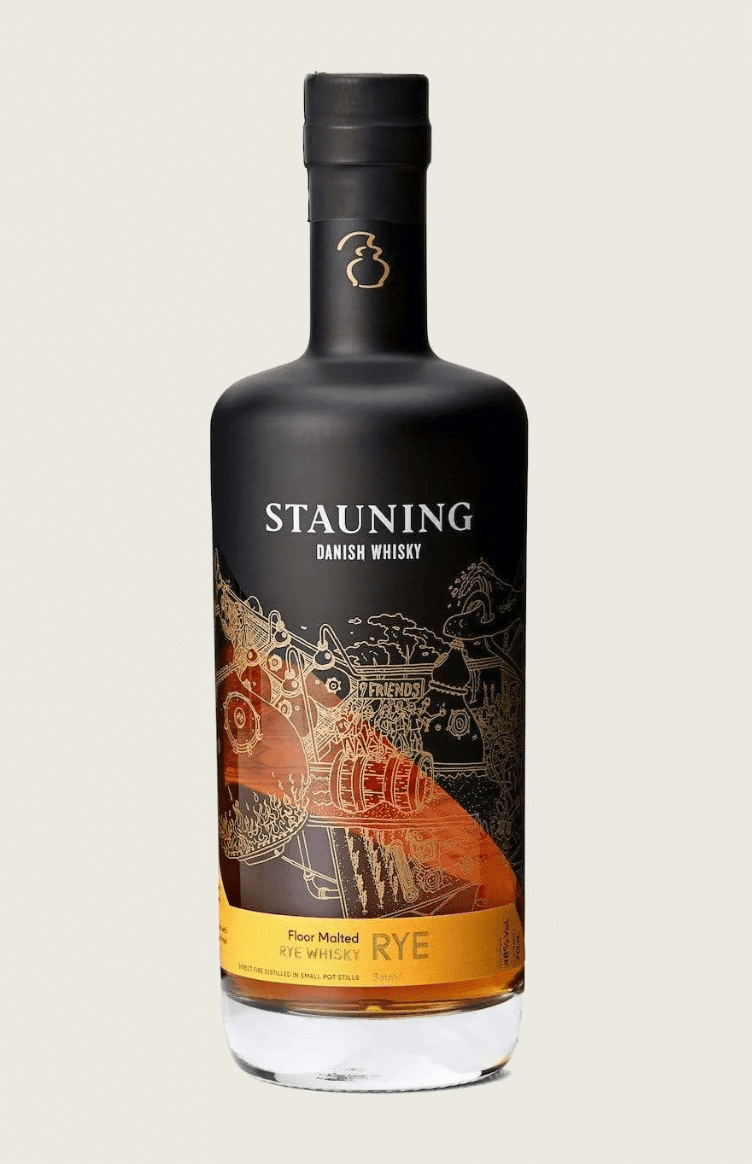
| Aspect | Details |
|---|---|
| Taste | Espresso, dark chocolate, smoke, allspice, clove, caraway |
| Color | Deep amber to mahogany |
| Price | $70-$80 |
| Major Components | Locally grown rye, Denmark, unique aging |
7. Best Locavore: Whistlepig FarmStock Beyond Bonded Rye
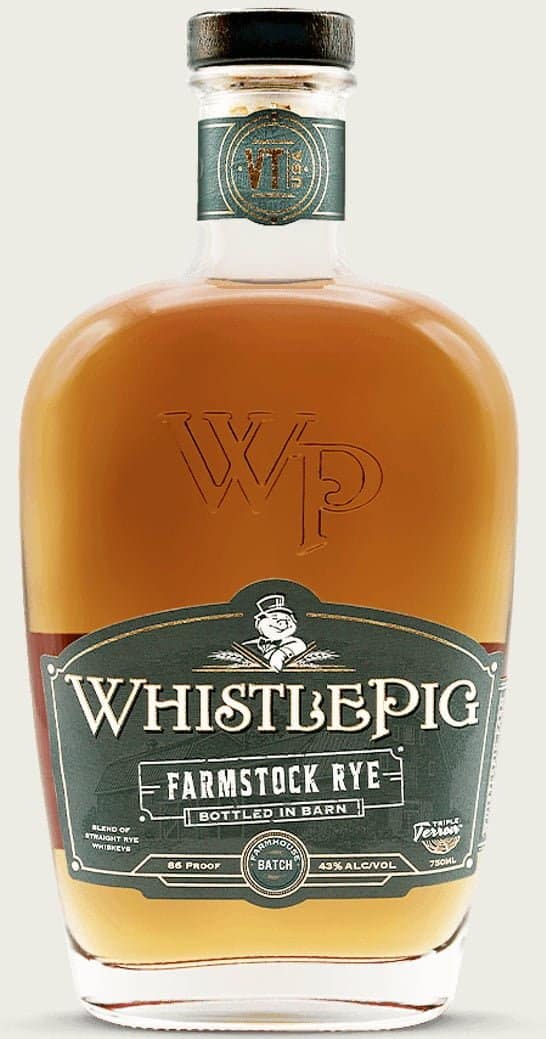
| Aspect | Details |
|---|---|
| Taste | Toffee, oak, toasted grain, coffee, honeycomb, vanilla, citrus, baking spice |
| Color | Rich amber |
| Price | $100-$150 |
| Major Components | 100% rye, Vermont farm, Vermont oak barrels |
Guidance While Selecting Rye & Bourbon

1. Personal Preferences
- Flavor Affinity: When selecting between rye and bourbon, consider your taste preferences. Rye whiskey might be perfect if you enjoy bold, spicy flavors with a peppery kick. On the other hand, if you prefer smoother, sweeter notes of caramel and vanilla, bourbon may be more appealing. Consider the flavors you enjoy in other drinks or foods, and let that guide your whiskey selection.
- Experience with Spirits: Bourbon can be a friendly introduction for those new to whiskey due to its generally smoother, sweeter profile. Its mellow character makes it an approachable choice for novice drinkers. More experienced whiskey enthusiasts may appreciate the complex spiciness and depth of rye. When tasting either type, try sipping it neat, with a splash of water, or on ice to discover how the flavors evolve and which enjoyment method you prefer.
2. Situational Recommendations
- Occasion and Setting: The occasion and setting can influence your choice between rye and bourbon. Bourbon’s smooth, easy-drinking nature may be the perfect fit for casual, relaxed gatherings like a backyard barbecue or a night in with friends. Its sweetness pairs well with classic American fare, like burgers or grilled meats. With its bolder, spicier character, Rye can be a sophisticated choice for more formal occasions or dinner parties, especially when paired with savory dishes like steak or charcuterie.
- Cocktail Suitability: When crafting cocktails, consider the flavor profile you want to achieve. Rye’s spicy, assertive notes shine in drinks like the Manhattan, Old Pal, or Sazerac, where its boldness can stand up to the complex flavors of vermouth and bitters. Bourbon’s sweeter, smoother profile is ideal for cocktails like the Old Fashioned, Mint Julep, or Whiskey Sour, whose mellow character complements the sweetness of sugar and the brightness of citrus. Let your cocktail’s desired balance of flavors guide your choice between rye and bourbon.
Conclusion
Last, the choice between rye and bourbon ultimately comes down to your taste preferences and the occasion.
Whether you prefer the bold, spicy notes of rye or the smooth, sweet character of bourbon, both whiskeys offer a unique and rewarding experience.
By understanding the key differences in their production, history, and flavor profiles, you can make an informed decision when selecting the perfect whiskey for sipping neat or crafting your favorite cocktail.
Remember, there’s no right or wrong choice – the best whiskey is the one you enjoy most.
So, go ahead and explore the diverse world of rye and bourbon, and savor the rich, complex flavors these classic American spirits offer.
Cheers to finding your new favorite whiskey!
Frequently Asked Questions
What are the Three Requirements for Bourbon?
While most rye whiskeys contain a blend of grains, some Canadian distillers produce 100% rye whiskeys, crafting spirits made entirely from rye grain for a unique flavor profile.
What are the Requirements for Rye Whiskey?
To be classified as rye whiskey in the United States, the mash bill must contain at least 51% rye grain, and the whiskey must be aged in new, charred oak barrels.
What is Special About Rye Whiskey?
Rye whiskey is known for its distinctive spicy, peppery, and bold flavor profile, which sets it apart from other whiskeys. This unique taste comes from the mash bill’s high percentage of rye grain.
Is Rye Easier to Drink than Bourbon?
The ease of drinking rye or bourbon depends on personal taste preferences. Rye whiskey’s spicy, bold flavors might be more challenging for some, while bourbon’s sweeter, smoother profile is often considered more approachable for novice whiskey drinkers.
Which Whiskey is 100% Rye?
While most rye whiskeys contain other grains, some Canadian distillers craft unique spirits made entirely from rye, known as 100% rye whiskeys, showcasing the distinctive spicy flavor of the grain.

